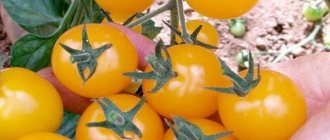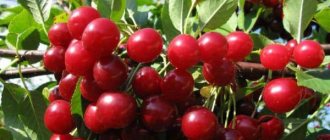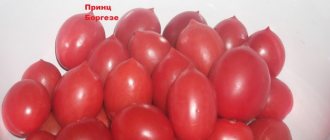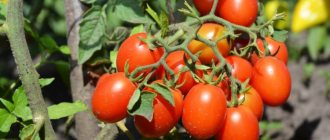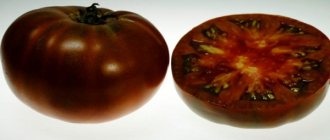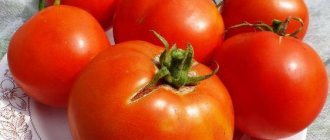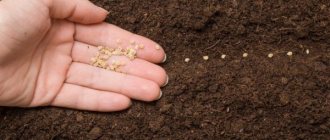Red cherry is a cherry tomato known and loved by many gardeners. Included in the State Register in 1997. It enjoys well-deserved love for its amazing taste and convenience of agricultural technology.
| Height | Landing location | Ripening time | Fruit color | Fruit size | Origin | Fruit shape |
| Tall | Greenhouse, Open ground | Early ripening | Reds | Small | Variety | Round |
Red Cherry tomatoes: variety description
The Red Cherry tomato is not a hybrid, although it is often confused with the hybrid Winter Cherry. This is an early ripening variety, characterized by productivity and tallness. The variety is quite productive; from one plant you can harvest up to 2 kg of small dessert tomatoes .
The bush is non-standard, indeterminate, with a height of 1.5 to 2 m and above. From the appearance of sprouts to harvest, only 85-100 days pass. The plant is tall, weakly leafy, spreading, with medium branching. The leaves are small, without stipules, dark, slightly corrugated. The first fruit cluster is laid above 8-9 leaves, and then after 3 leaves. Form a bush with 1 stem. Excellent for growing in open ground, but also grows well in a greenhouse. It can sometimes be affected by fusarium and tobacco mosaic, is resistant to brown spot (cladosporiosis) and very rarely suffers from pest attacks. Due to its precocity, it is almost not susceptible to late blight and root rot.
You can compare the yield of a variety using the table data:
| Variety name | Productivity |
| Cherry red | 2 kg per bush |
| Marissa | 20-24 kg per square meter |
| Sugar cream | 8 kg per square meter |
| Buddy f1 | 8-10 kg per square meter |
| Siberian early ripening | 6-7 kg per square meter |
| Golden stream | 8-10 kg per square meter |
| Pride of Siberia | 23-25 kg per square meter |
| Liana | 2-3 kg per bush |
| The Lazy Man's Miracle | 8 kg per square meter |
| President 2 | 5 kg per bush |
| Leopold | 3-4 kg per bush |
History of the variety
The Red Cherry tomato was obtained by breeders of the famous Russian seed farming company Gavrish back in the early 90s of the 20th century. In 1997, this tomato variety was successfully included in the State Register of Breeding Achievements of Russia. It is recommended for cultivation in any region of our country in open or closed ground conditions.
For the Gavrish company, this variety was one of the first cherry tomatoes that they presented to the public, so its name immediately determines its belonging to this dessert group of tomatoes. From the same series, you can also find Yellow Cherry tomato from manufacturers with very similar characteristics, but with yellow fruits.
Comment! Since at that time there were still very few domestically produced cherry tomatoes in our country, people often called the variety in a foreign manner - red cherry.
And many people still sometimes confuse it with various cherry hybrids, such as Winter Cherry. Therefore, it should be clarified that the Red Cherry tomato is precisely a variety and seeds obtained from fruits grown with one’s own hands can be used in the future for sowing while maintaining all the original parental qualities.
Also, this variety should not be confused with small-fruited tomatoes such as Balcony Miracle, Pinocchio and others. Similar varieties of tomatoes were bred more for decorative purposes and for growing in rooms and on balconies. Moreover, their fruits are large in size - 30-40 grams, and the plants themselves have completely different characteristics than cherry varieties.
Characteristics
The tomatoes are very small, round, bright red, weighing about 15-35 grams . They grow in clusters, 20-35 pieces each. The skin is smooth, thin, and may crack when overripe. The average number of chambers in fruits is 2-3, and the content of dry substances and sugars is 10-12%. Maturation in the hand is heterogeneous. The taste is very pleasant, sweet.
The fruits are not intended for commercial use and do not tolerate transportation well. Can be stored in the refrigerator for no more than a month. Often used for canning and pickling whole clusters. Can be used fresh for buffet appetizers and salads. The fruits begin to ripen in July, but they must be collected only when fully ripe to preserve the taste.
You can compare the weight of the fruits of this variety with others in the table:
| Variety name | Fruit weight |
| Cherry red | 15-35 grams |
| La la fa | 130-160 grams |
| Alpatieva 905A | 60 grams |
| Pink flamingo | 150-450 grams |
| Tanya | 150-170 grams |
| Apparently invisible | 280-330 grams |
| Early love | 85-95 grams |
| Baron | 150-200 grams |
| Yablonka Russia | 80 grams |
| Valentina | 80-90 grams |
| Kate | 120-130 grams |
Harvest and storage
Tomato cultivation always ends with the collection of ripe tomato fruits. This can be done at any stage of maturity - it all depends on the purpose of harvesting. Therefore, some even harvest the fruits when they are in the first stage of ripeness.
Most often, gardeners collect ripe red tomatoes, which are used to prepare fresh vegetable salads or winter preserves. Brown tomatoes are collected to be pickled or pickled in barrels.
Green or pink fruits are not collected as often, as they have a specific taste. However, despite this, they can be used for preserving salads or other dishes.
Boxes or cardboard boxes are used to store the harvested crop. It is recommended to cover the bottom with cardboard or paper to prevent the tomatoes from rotting during storage.
Advantages and disadvantages
Red cherries have few disadvantages. She is unpretentious and undemanding in care.
The main advantages are:
- early ripeness;
- great taste;
- resistance to temperature changes and major diseases;
- suitability for whole-fruit canning with brushes;
- decorativeness.
Of the minuses it is worth noting:
- tallness;
- requires mandatory garter and regular pinching;
- not suitable for long-term storage and transportation;
- increased demands on sunlight and fertilizing.
The variety is very sensitive to soil moisture content. If there is insufficient watering, the fruits dry out, become brown, and if over-watered, they become watery.
Pick tomatoes on time
Planting and caring for this variety is simple.
| Stage 1. Plant in a permanent place Apply compost or rotted manure. The norm is a bucket per square, after which the field is immediately dug up onto the bayonet of a shovel. Make holes according to the pattern 40x50 cm . Plant the tomatoes with a lump of soil, compact the surface and water well | |
| Stage 2: Water once a week A day or two before work, fill a container with water. It should warm up to ambient temperature and settle. It is better to water after sunset . Use at least 5 liters per bush; as the bushes grow, the rate increases by another 2-3 liters | |
| Stage 3. Loosen and weed constantly Loosen after each watering. This reduces water evaporation and saturates the soil with oxygen. Weed the rows every 2 weeks . Weeds are often the cause of pests; they need to be removed promptly | |
| Stage 4. Fertilize every 3 weeks Buy a complex composition for tomatoes. You can also use organic options and solutions for foliar feeding. Alternate different types of fertilizers . This gives better results | |
| Stage 5. Tie up bushes Option 1. Drive a high peg near each seedling and tie the stem. Tie up as the plant grows. Option 2 . Stretch the trellis or place a crossbar on top and tie pieces of twine to it, along which the tomatoes are carried | |
| Stage 6. Pick tomatoes on time Pick tomatoes as they ripen. This way they will not crack and the yield will increase. Remove all rotten and spoiled fruits. |
Features of cultivation
The best areas for red cherries are: the central zone of the Russian Federation, Ukraine, Belarus and Moldova. This is the earliest variety of cherry tomatoes. It contains a huge amount of vitamins, minerals and solids. With a lack of sunlight, tomatoes lose their beneficial properties.
Seeds are sown for seedlings in March or April. Seedlings are placed in open ground in May. All stepsons are removed after the formation of the fifth inflorescence. When 8-9 clusters are formed, the stem is pinched and only 2 leaves are left above the last cluster.
There are 2-3 bushes per square meter. Water at least 2 times a week, abundantly . Feed during the period of fruit growth and ripening with mineral and organic fertilizers.
Read on our website: how to get a high yield of tomatoes in open ground? How to grow delicious tomatoes in a greenhouse in winter? What are the subtleties of agricultural technology for early varieties?
Treat with a growth stimulator
| Stage 1. Purchase quality seeds Calculate the approximate amount of planting material. Add 20-30% in reserve, since not all seeds germinate. Buy seeds in the store . You should not buy seed in trays and markets, the quality there is very low and very often the bags are not what is indicated on the package | |
| Stage 2. Disinfect the seeds Make a not very strong infusion of potassium permanganate, something like the one in the photo. Stir the liquid well until the crystals dissolve completely. Soak the seeds for 20 minutes . After removal, be sure to rinse in warm water. | |
| Stage 3. Treat with a growth stimulator Buy any stimulating composition at a gardening store. Study the information on the packaging to know all the features of using the solution and maintain the correct proportions. Make a solution and place seeds in it . Leave for as long as necessary, then remove the planting material and dry it | |
| Stage 4. Plant tomatoes Prepare containers for seedlings. Fill them with ready-made soil, which is purchased in advance, and water it. Seeds are sown every 2-3 cm . Leave about 3 cm between the rows. Cover the seeds with a layer of soil about a centimeter thick. Place in a warm place and cover with plastic . After the shoots emerge, remove the film and place it on the windowsill. | |
| Stage 5. Pick up seedlings After two or more true leaves appear, the plants need to be planted in separate containers.. To do this, they are carefully removed with a lump of earth in order to damage the roots as little as possible. Plant in cups or pots . After replanting, water well and compact the soil. | |
| Stage 6. Care for tomatoes correctly Spray the ground part with a spray bottle with warm water. This should be done in the mornings and evenings. Water once a week or a little less often . To navigate the soil when it is dry, it means the plants need moisture. Harden off two weeks before planting . Take outside or leave near an open window for 3-4 hours |
Diseases and pests
Fusarium and tobacco mosaic affect the leaves and reduce the plant's immunity. An infected plant cannot be cured; it dies. To prevent the appearance of these dangerous diseases, it is necessary to avoid waterlogging of the soil, provide the plant with good lighting and carefully carry out pinching.
Red cherry is a wonderful variety that does not require much effort when growing. To get a good harvest, standard conditions are sufficient: gartering, pinching, fertilizing and watering.
| Mid-season | Mid-early | Late ripening |
| Anastasia | Budenovka | Premier |
| Raspberry wine | Mystery of nature | Grapefruit |
| Royal gift | Pink King | De Barao the Giant |
| Malachite Box | Cardinal | De Barao |
| Pink heart | Babushkino | Yusupovsky |
| Cypress | Lev Tolstoy | Altaic |
| Giant raspberry | Danko | Rocket |
Reviews from gardeners
Anna, Samara
“Cherry” produced more fruits outside, in an ordinary garden bed. And the tomatoes didn’t crack at all. The cherry bushes themselves on the street did not grow very tall, about 70 centimeters, and the clusters were richly strewn with fruits.
Source: otzovik.com
Raisa, Moscow
I would like to note the taste. The crumbs are very tasty, sweet and fragrant. They also turned out great when pickled. Very beautiful and tasty.
Source: otzovik.com
What is a variety
Fans of plants with berry fruits imagine cherry as a real curiosity. To understand what a tree is, it is necessary to consider what is more in it, cherries or cherries.
If we talk about science, Duke is an even hybrid of both crops, and pollination occurred in a completely natural way. This situation clearly interested breeders, and they began to study the issue of such pollination.
In Russia, such crossing appeared only in the 90s and the Winkler cherry variety and Bel cherry were used. Scientists hoped to grow this hybrid in northern latitudes, so they obtained increased frost resistance from the plant. However, severe frosts were still stronger and the tree produced too little fruit.
Those specimens of hybrids that were brought to us from the West did not please scientists too much due to their thermophilic nature. Of the majority of cherry varieties, many produced too meager a harvest, and some did not bear fruit at all. Today the situation has largely changed for the better. Breeders have tried to develop an ideal variety for mid-latitudes that is resistant to disease and cold. In addition, the yield indicator has also increased.
Duke is a hybrid of cherry and sweet cherry, however, it still has more cherry characteristics. The appearance of the tree is a neat plant with a medium crown, symmetrical branches, oblong leaves, white inflorescences and large fruits of rich red color.
The tree is more reminiscent of cherries with its leaves, taste and aroma of berries. From cherries, the plant took the size of the fruits and their sugar content. The average weight of one cherry berry is 20 grams. In the third year, the plant begins to bear fruit and produces up to 10 kg of berries per season.
Diseases and insects
The Red Cherry tomato is resistant to root rot and brown spot. But it can be affected by other fungal and infectious diseases. Due to the fact that the variety ripens quickly, it is also not damaged by late blight, which can often be seen on melons. The description says that insects do not attack it very often.
Often this type of cherry is affected by diseases such as tobacco mosaic and fusarium. Such diseases cannot be treated, because they destroy the plant in a short period. Therefore, if signs of these diseases appear on a tomato bush, the plant should be pulled out. This way you can prevent other bushes from becoming infected.
To prevent such problems from arising, it is necessary to carry out prevention against diseases and parasites. It lies in proper care. If you water, fertilize, and remove weeds correctly, you will not have such problems. Also, to prevent the appearance of insects, you can plant plants nearby that are afraid of melon parasites.
Recommendations for planting and care
To achieve a good harvest, the gardener needs to take the right approach to planting and caring for plants. This way you can ensure better fertility and taste of tomatoes.
Preparation of planting material
To obtain a harvest, you need to use healthy, full-bodied seeds. The day before planting, it is recommended to treat the seed with a weak solution of potassium permanganate, placing them in the liquid for 10 minutes. After this, it is important to dry the seeds thoroughly.
When using seedlings, procedures should be carried out to harden the plant. This way you can increase the resistance of tomatoes to pathogens. After 3-4 leaves appear on the stem, you need to remove the seedlings from greenhouse conditions to the street, avoiding direct sunlight and strong winds. You need to start with 15 minutes, gradually increasing to an hour. During the hardening process, the bush acquires a purple tint. You should not be afraid of such changes - this is an adequate reaction of the plant to changing conditions.
Site selection
When choosing a suitable location, you need to consider the following items:
- lighting must be provided. That is, you need to avoid the shadow of a country house or garden trees. It is best to plant in the center of the garden;
- Features of crop rotation are important both for ensuring productivity and for preserving the very fact of fertility. Therefore, planting should be carried out taking into account what grew in this area last season;
- Special attention should be paid to the possibility of installing structures for tying bushes. Due to their growth, problems may arise with processing the plant and providing the vegetable crop with nutrients.
You also need to remember about the requirements of tomatoes for the composition of the soil.
Tomato planting dates and patterns
The optimal planting period is from the last days of May to mid-July. At this time of year, night frosts stop, weather conditions allow you not to worry about “tender” seedlings.
Landing is carried out as follows:
- Make small holes at a distance of 0.6 meters from each other.
- Pour water into the holes and wait until it is absorbed.
- Place the root in wet soil and sprinkle with dry soil - the stem should be half under the soil.
- Lightly compact the soil and water again using a watering can.
You can pre-install pegs for subsequent garter. This way you can mitigate the risks of damage to the root system when installing them in the future. It is necessary to choose pegs such that they rise above ground level to a height of at least two meters.
Watering and fertilizing
To get a good harvest, you need to carry out care measures:
- Water.
- Feed the soil.
- Remove weeds.
- Mulch the ground.
Watering should be done by analogy with other varieties of tomatoes. That is, there is no need to be overly zealous and flood the bushes every day. Otherwise, rotting processes in the root system may develop, which will lead to the death of all plants.
See also: Effective means for protecting and treating tomatoes against late blight
However, you should not delay watering. Like every crop, the Red Cherry tomato needs water to develop and ensure fertility. Therefore, it is recommended to follow the general rules (water two to three times a week), without neglecting to take into account nuances in the form of changing weather conditions or the occurrence of diseases and small pests in the bushes.
Fertilizer should be done before planting seedlings. You can use both organic products and chemicals. Experienced gardeners use:
- compost;
- manure;
- phosphorus;
- nitrogen;
- boric acid solution.
In any case, you need to follow the fertilizing schedule so as not to overdo it with the plant. The bush can “suffocate” from excessive amounts of organic products or get burned from too thorough treatment with chemicals.
Formation
If the seedlings of the Red Cherry variety have taken root and are developing, you need to monitor the number of inflorescences on the plant:
- When 5 inflorescences appear, the stepsons should be cut off.
- When 9 pieces appear, you need to pinch the trunk of the bush. It is important to take into account that no more than two leaves remain above the last brush.
- In the future, as the plant grows, it needs to be tied up - heavy brushes can lead to stem breakage.
If you ignore the need for this procedure, there is a high risk of reducing the fertility of the variety. The plant will spend nutrients not on tomatoes, but on the formation of leaves. The root system will subsequently be unable to cope with providing nutrition to the entire bush, which will lead to yellowing of the leaves and their death.
Protection from insects and diseases
Due to the speed of ripening, this tomato variety is protected from:
- root rot;
- cladosporiosis;
- late blight;
- It is also resistant to pest attacks.
The plant is more susceptible to the negative effects of tobacco mosaic and fusarium. If an infection occurs, there is no point in treating it - you need to quickly remove the affected bushes (it is recommended to burn them) to prevent further development of the infection.
However, if the requirements for care, planting, carrying out agrotechnical procedures and preventive measures are met, it is possible to level out the risks of diseases in this variety.
Other varieties of tomatoes Cherry
There are other varieties of the Cherry variety:
- Winter cherry;
- Red cherry;
- Royal cherry;
- White cherry;
- Yellow cherry.
Fruits differ not only in color, but also in other characteristics. But they are united by one quality - unpretentiousness. Therefore, even novice gardeners can grow these varieties. All of them are often attacked by late blight, so it is worth taking all preventive measures in advance.
Planting in open ground
Plants should be transferred to unprotected soil after the risk of repeated frosts has been removed and the average daily temperature has established itself within 22-24C. In mid-latitudes this is usually mid to late May. By this time, 4-6 true leaves should form on each bush.
Planting without seedlings is possible in more southern latitudes when the average daily temperature is not lower than 20C and the top layer of soil is warmed to at least 15C (April-May).
Important! Cherry tomatoes Red cherry require a larger distance between the bushes than other varieties - not 20-30 cm, as usual, but at least 50 cm!
Read on the topic: What to put in the hole when planting tomatoes?
